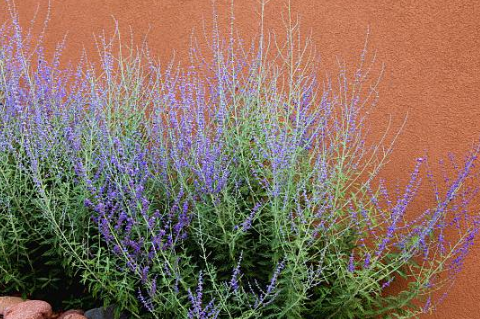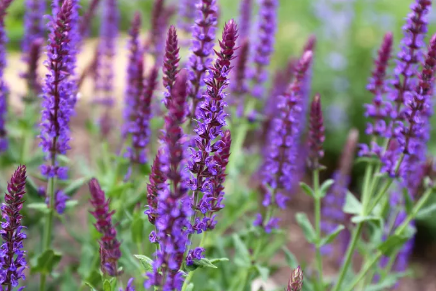There’s a reason sage has become a staple in landscape design—its nectar-rich blooms attract pollinators, it has a long flowering season, is generally deer- and rabbit-resistant, and it handles drought well. Sage (Salvia) is the largest genus in the mint family (Lamiaceae), including annuals, perennials, and culinary varieties. It grows across a wide range of USDA hardiness zones, and comes in many shapes, sizes, and colors.
Here’s how to make the most of sage in your yard:
How to Use Sage in Landscaping
You don’t need to confine sage to just one spot. With so many varieties available, sage is incredibly versatile. You can use it in your landscape in the following ways:
-
As a Ground Cover
Low to medium-height sages (1–2 feet tall) spread horizontally and make excellent ground covers. Growth rates and spread vary by species, with heights ranging from 12 inches to 4 feet or more. If you want fast coverage, go for quick-spreading types like Salvia lyrata (lyreleaf sage). -
For Privacy Screening
Shrubby types like Mexican bush sage (Salvia leucantha) or bog sage (Salvia uliginosa) can grow up to 5 feet tall and equally wide, making them great choices for natural privacy hedges.

-
To Add Height Variety
Sage varieties range greatly in height, so you can easily mix and match to create layers. When planting, pay attention to sun patterns so taller varieties don’t block sunlight from smaller plants. -
Along Borders
Sage works beautifully along garden borders. Plant it with other sun-loving, drought-tolerant plants. Place shorter sages in the front of the border and taller ones in the back for visual depth. -
To Attract Wildlife
Sage’s tubular flowers are rich in nectar and a top choice for hummingbirds. They also draw in bees, bumblebees, native bees, and butterflies. Its seeds provide food for finches, goldfinches, and other birds. -
For Water-Wise Gardening
Once established, most sages are drought-tolerant, making them ideal for xeriscaping. Varieties like desert sage (Salvia dorrii), mealycup sage (Salvia farinacea), and hummingbird sage are particularly well-suited for hot, dry climates.In prolonged dry periods, deep and infrequent watering is best to encourage strong root systems.
Popular Types of Sage to Grow
Each sage variety offers different benefits. Here are a few favorites you can plant in your front yard:
-
Scarlet Sage (Salvia splendens)
Native to Brazil, this tender perennial (USDA zones 10–11) is grown as an annual elsewhere. It blooms from summer into fall with bright scarlet flowers—though varieties also come in white, pink, purple, lavender, burgundy, and orange.
Perfect for borders or containers, it grows 1–2 feet tall and 9–18 inches wide. Unlike most sages, it prefers consistently moist but well-drained soil rich in organic matter. -
Blue Sage (Salvia azurea)
Also known as pitcher sage, this hardy native perennial grows in USDA zones 4–9. It blooms from mid-summer to fall, attracting bees and butterflies with striking blue flowers.
It reaches 4–5 feet tall and 2–4 feet wide and thrives in sandy or rocky soil. It prefers moist, well-drained soil but can tolerate occasional drought.

-
Meadow Sage (Salvia x sylvestris)
A fast-growing, upright hybrid (zones 4–8), ‘May Night’ meadow sage blooms in vivid purple-blue tones throughout summer. It grows 1.5–2 feet tall and about 1–1.5 feet wide.
Well-drained soil is essential—mix in sand if needed. While heat- and drought-tolerant, it puts on the best flower show in cooler weather. -
Creeping Sage (Salvia sonomensis)
Native to California, this lesser-known sage is a fantastic choice for drought-tolerant, mat-forming ground cover. It blooms in May and June with blue-violet flower spikes that rise about 6 inches above evergreen foliage.
This low-growing sage stays under 12 inches tall but can spread 10 to 15 feet wide. It thrives in full sun to part shade (such as under shrubs), in sandy, loamy, or clay soils with excellent drainage. Avoid frequent summer watering.
Whether you’re creating pollinator habitats, looking for beautiful color, or aiming to reduce water use, sage is a reliable and rewarding plant to include in your small front yard garden.

